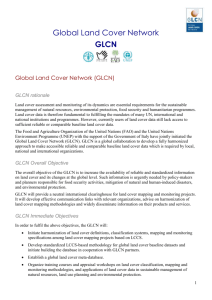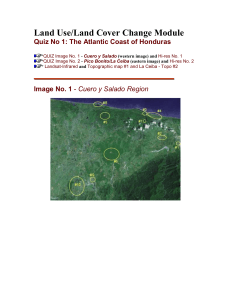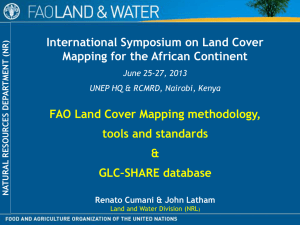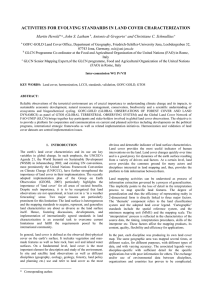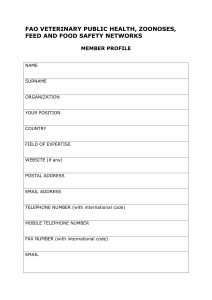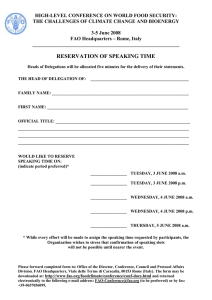Environment and Natural Resources Service (SDRN)
advertisement
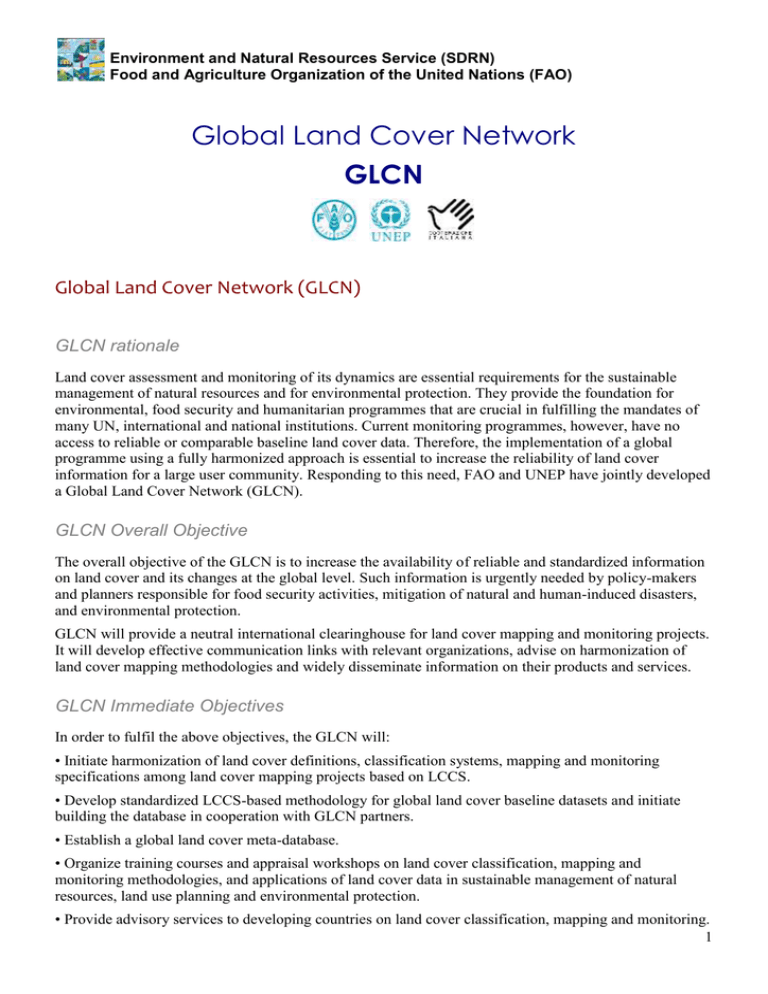
Environment and Natural Resources Service (SDRN) Food and Agriculture Organization of the United Nations (FAO) Global Land Cover Network GLCN Global Land Cover Network (GLCN) GLCN rationale Land cover assessment and monitoring of its dynamics are essential requirements for the sustainable management of natural resources and for environmental protection. They provide the foundation for environmental, food security and humanitarian programmes that are crucial in fulfilling the mandates of many UN, international and national institutions. Current monitoring programmes, however, have no access to reliable or comparable baseline land cover data. Therefore, the implementation of a global programme using a fully harmonized approach is essential to increase the reliability of land cover information for a large user community. Responding to this need, FAO and UNEP have jointly developed a Global Land Cover Network (GLCN). GLCN Overall Objective The overall objective of the GLCN is to increase the availability of reliable and standardized information on land cover and its changes at the global level. Such information is urgently needed by policy-makers and planners responsible for food security activities, mitigation of natural and human-induced disasters, and environmental protection. GLCN will provide a neutral international clearinghouse for land cover mapping and monitoring projects. It will develop effective communication links with relevant organizations, advise on harmonization of land cover mapping methodologies and widely disseminate information on their products and services. GLCN Immediate Objectives In order to fulfil the above objectives, the GLCN will: • Initiate harmonization of land cover definitions, classification systems, mapping and monitoring specifications among land cover mapping projects based on LCCS. • Develop standardized LCCS-based methodology for global land cover baseline datasets and initiate building the database in cooperation with GLCN partners. • Establish a global land cover meta-database. • Organize training courses and appraisal workshops on land cover classification, mapping and monitoring methodologies, and applications of land cover data in sustainable management of natural resources, land use planning and environmental protection. • Provide advisory services to developing countries on land cover classification, mapping and monitoring. 1 • Function as an international, politically neutral and not-for-profit clearinghouse for land cover information at global and regional levels. Land Cover Unit at FAO and Coordination Unit at UNEP The FAO Land Cover Unit will carry out activities including: linking land cover and land use; socioeconomic and biophysical indicators of land cover change trends; models for prediction of land cover change trends; and models for the assessment of the impact of land cover change on food security. Responsibilities of the UNEP Coordination will include: development and coordination of a global network of regional and national land cover focal points and establishing linkages with UN Conventions. Other activities will include linkages to institutional (international and national) land cover databases and development and management of a global network of permanent land cover validation sites. Africover project GLCN is based on the success of the Africover project. Africover was established to develop a digital georeferenced database on land cover and a geographic referential for the whole of Africa including: geodetical homogeneous referential, toponomy, roads and hydrography. The Africover project was established in response to a number of national requests for assistance to the development of reliable and georeferenced information on natural resources required at subnational, national and regional levels. This data is needed for: early warning; food security; agriculture; disaster prevention and management; forest and rangeland monitoring; environmental planning; watershed catchments management; statistics on natural resources; biodiversity studies, and climate change modeling. The Multipurpose Africover Database for the Environmental Resources (MADE) is produced at a scale of 1:200,000 (and at 1:100,000 for small countries and specific areas). Reinforcing national and subregional capacities for the establishment, update and use of land cover maps and spatial data bases is the core strategy of Africover. This has been the method adopted to ensure an operational approach and the sustainability of the initiative. Hence, the purpose of Africover is to produce the geographic information required for decision making, planning and natural resources management in African countries. Additional details: www.africover.org Tools used in GLCN projects Introduction to Land Cover Classification At present there is no internationally accepted land cover classification system. Some are more universally applicable than others; for example, the USGS land cover and land use classification system (Anderson et al., 1976) has been widely used, but none has been accepted as the international standard. The main reason is the large number of pre-defined land cover classes that would be needed to adequately represent the diversity of applications and geographic conditions over large areas. 2 Yet, the increasing number of regional/continental and global initiatives involving land cover mapping and monitoring requires a close interaction among them, otherwise their benefits would be diminished. Since land cover has become a basic data layer in GIS models for comprehensive environmental assessment, the synergy among land cover mapping projects is a high priority. It can be best achieved through development of a common, harmonized land cover classification system for global environmental applications. FAO and UNEP have laid the foundation to such a system (Di Gregorio and Jansen, 2000). The Land Cover Classification System (LCCS) The FAO/UNEP land cover classification system (LCCS) is the only universally applicable classification system in operational use at present. It enables a comparison of land cover classes regardless of data source, economic sector or country. Most other land cover classification systems are single-purpose systems, tailored to requirements of a specific project or based on a sectorial approach. The LCCS method enhances the standardization process and minimizes the problem of dealing with a very large amount of pre-defined classes. LCCS is based on independent and universally valid land cover diagnostic criteria rather than on a predefined set of land cover classes. Its output is a comprehensive land cover characterization, regardless of mapping scale, land cover type, data collection method or geographic location. The LCCS has the best potential to become accepted as the international land cover classification standard because of its inherent flexibility, applicability in all climatic zones and environmental conditions, and compatibility with the existing classification systems. The LCCS design (Di Gregorio and Jansen, 2000) is based on the following unique concept: instead of pre-defining the land cover classes, a set of universally valid classification criteria that uniquely identify the land cover classes worldwide was selected. This presumes that any land cover class, regardless of its type and geographic location, can be defined by a set of preselected independent diagnostic attributes, the “classifiers”. The number of classifiers used determines the level at which the land cover is classified. Thus, the larger number of classifiers is needed when more detailed classification of land cover is required. The advantages of the FAO/UNEP Land Cover Classification System are manifold. It is a highly flexible system in which each land cover class is mutually exclusive and clearly defined, thus providing internal consistency. These characteristics are independent of the classification level. The classification can be stopped at any desired level and will still result in clearly defined land cover classes corresponding to that level. Any land cover type can be readily accommodated. The system is truly hierarchical and applicable to a variety of mapping scales and in any geographic location. It can be used as a reference standard system because its diagnostic criteria allow correlation with existing classifications and legends. FAO/UNEP has submitted the Land Cover Classification System (LCCS) for approval to become an ISO standard. The International Organization for Standardization (ISO) is the world's largest developer of standards. It is a network of 147 national standards institutes with a Central Secretariat in Geneva, Switzerland (for additional information see www.iso.org). Through the normal procedures it is anticipated that LCCS should become an ISO standard by 2005. 3 The organizations involved in the validation process of LCCS are: • GLC 2000 (Global Land Cover mapping) - Joint Research Center (JRC) ISPRA; • UNEP - United Nations Environment Programme; • FGDC - Federal Geographic Data Committee; • GLUCC - Global Land Use Cover Classification, working group of IGBP (International Geosphere/Biosphere Programme). AIMs It is derived from a core image-processing package updated with a series of vector based functionalities. It enables an interactive use of ancillary data by combining different types of data in geographically linked windows. In particular, the software will facilitate image analysis of a large number of optical as well as radar (SAR) satellite images. Drawing of polygons and lines, cursor positioning, planning and zooming are done in a seamless way. The system will be able to produce map sheets at selected scales of countries with different cartographic systems. AIMS will be used for thematic enhancement of the database (when for instance the land cover layer must be updated with other thematic maps still on raster format) or when different remote sensing data must be used in the same time (e.g. Optical and Radar data in cloudy areas, images of different seasons or data with different spectral and spatial resolution, etc.). The major limitation of the system is that due to the format of the vector layer (basically a “spaghetti vector” with full export capability in shape file) the user must have a substantial knowledge of vector GIS when performing the interpretation. In addition a specialized GIS work will be needed in order to create the final “topological” database. GeoVIS GeoVIS is the latest software created. Contrary to AIMs it has been developed starting from a vector based digitization software, it therefore has much more advanced vector functions for the on screen polygon digitization. This makes the interpretation activity much simpler and reduces the GIS work needed to build the database. The major limitations are the limited raster functions (absence of automatic classification, geographically linked windows). However these limitations will be updated in the next version of the system. The main features of GeoVIS are: Ergonomic environment for visual interpretation: - support for pure visual, mixed visual-automatic interpretation and pure automatic (in version 2); - magic wand tool for mixed interpretation; - direct link with LCCS (drag and drop supported); - multiple windows with synchronized panning, zooming and feature drawing (in version 2); - image stretching and filtering; - image compression with Radex technology. 4 Fully topological but easy to use: - fully topological; - file output compliant with all topological software (like ESRI Arc Info); - topological copy-and-paste of features between layers; - easy to use topological editing (split, merge, etc.). Data base functionalities: - integration of field samples information (with visual and tabular info); - joining of tables; - querying capabilities. Databases GLCN will be supported using the software developed in the Africover project. This includes tools to produce and maintain databases as well as software to use it and fully liberate the information stored through the LCCS system. The GLCN data portal will be based on the ADG (Africover Database Gateway) and AID (Africover Interactive Database) software aimed to enhance the use and the updating of the Africover product by end-users. ADG: Is a cross-cutting interrogation software; its main function is to allow an easy and fast recombination of the land cover polygons, not only by class name but also by classifiers. The end-users will be able to create their own classes using the set of existing classifiers by selectively recombining the database polygons. AID: Is an interactive software to guide and homogenize the land cover interpretation. Selected portions of different types of images, ground truth data and ancillary data will be organized in a logical, interactive way to guide the user in the identification of the variety of different land cover types. 5
